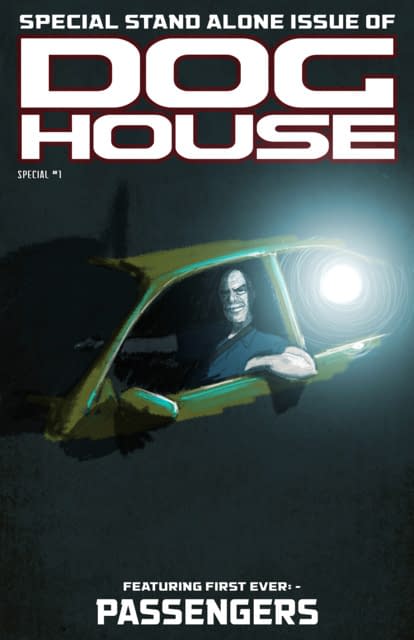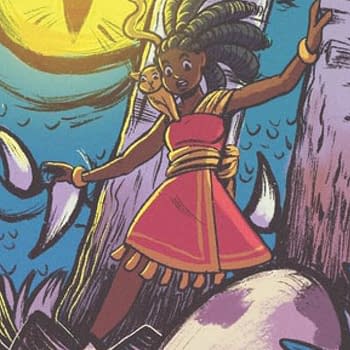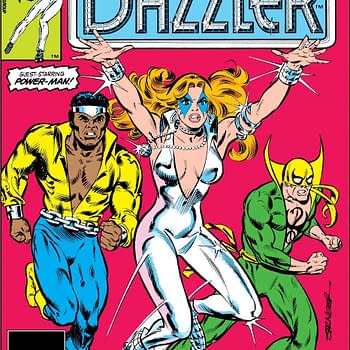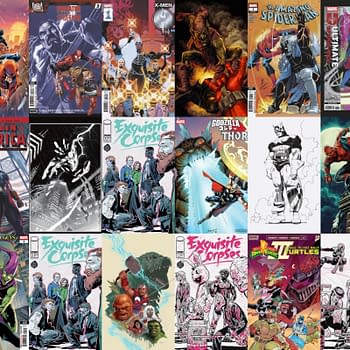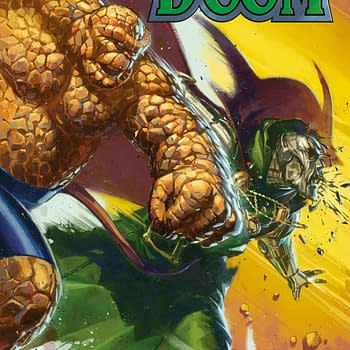Posted in: Comics, Recent Updates | Tagged: Alberto Albuerque, boom studios, brian azzarello, charles soule, Comics, comixology, dan jurgens, Dave Kennedy, dc comics, Doghouse Special, entertainment, grace randolph, jeff lemire, keith giffen, letter 44, Mike Sizemore, oni press, Supurbia Vol. 4, The New 52: Future's End
Thor's Comic Review Column – New 52: Futures End, Doghouse Special, Letter 44, Supurbia Vol. 4
This Week's Reviews:
The New 52: Futures End #17
Doghouse Special #1
Letter 44 #9
Supurbia, Vol. 4
The New 52: Futures End #17 (DC Comics, $2.99)
By Graig Kent
When I was a kid, a teenager really, I spent so much time with my comics. I would flip through each weekly pull at least twice before deciding what order to read them in, and most of them I would read twice. In many cases I would go back and read previous issues after reading the latest just to connect the threads and see what I missed. I would regularly pull out beloved collections and read entire runs, or pull all the comics off the shelves, stack them into piles around my room, and re-sort them, exactly like Rob Gordon and his record collection in High Fidelity.
I don't have that kind of time anymore. Family, job, pets, commitments, and the other copious forms of pop culture entertainment all compete for attention…I rarely read a single issue of any comic more than once at this stage, though I still bag'em up and box'em away for some later date when I think I may have the opportunity to get back to them.
I've been enjoying The New 52: Futures End every week since the debut "zero" issue on Free Comic Book Day but it's been one of those books I feel needs more time, and I haven't been giving it. I loved the Johns-Morrison-Rucka-Waid epic 52, which was definitely a title I would pour over every issue each week, reading it two, sometimes three times over in the same sitting, and just as often re-reading or flipping through the run-to-date. It was a thoroughly engrossing and entertaining series, the like which hasn't been duplicated since it ended. Futures End is actually giving it a go at measuring up, and while it's not nearly as immediately meaningful (its bears at best a theoretical sense of being part of the active DCU) it's telling a whopper of an engrossing story. It may well prove to be the actual new 52.
What 52 had that made it so great was mystery, and not just any mystery, but one that made the reader care about finding out the answers, and invest time thinking about the possible answers. It was a product of the Lost age, and for its year-long run rivaled that show for keeping the audiences bewildered. Futures End has mystery, but it doesn't have the same driving desire to find out, nor the same level of importance that the events of 52 had (perhaps because I'm far less invested in the New DCU as I was with the old.
Futures End takes place 5 years in the future, a time after the "Earth War" (in which, apparently, Earth One was invaded by Earth 2, the specifics of which are merely trickling out). Life has gotten a bit more complicated for our heroes, some of whom are dead, or just war-worn. Firestorm, for instance, finds Jason Rusch and Ronnie Raymond at odds about what their responsibilities are in the wake of so much bloodshed, which makes it hard when sharing brainspace.
The crux of the story, though, is that 35 years in the future, humanity has almost lost the fight entirely against Brother Eye and his cybernetic assimilation of all human life. Terry McGuinness/Batman Beyond, has returned to this time to destroy Brother Eye and stop this future from happening. Conventional Terminator-type stuff, but with Batman and superheroes, it gets a nice sprucing-up.
The writing team of Brian Azzarello, Keith Giffen, Dan Jurgens and Jeff Lemire are each operating a handful of ongoing plots which cycle in-and-out of each issue: McGuinness is teaming up with a trio of villains to bust into Mr. Terrific's corporate HQ (but with completely different objectives); Lois Lane is trying to figure out what a mystery package is all about; Grifter gets conscripted by Cadmus into working with Deathstroke and a nigh-powerful 12-year-old girl hunting Earth 2 refugees in hiding; Frankenstein, Amethyst and Ray Palmer are in space investigating the death of Stormwatch; Constantine is on the hunt for an ancient evil that wiped out earlier civilizations; Mr. Terrific is concerned about this future cyborg he found when confronting McGuinness; and Superman's not quite himself…and more, much more actually.
There are a lot of seemingly disparate threads running through Futures End, and week-to-week, it never seems like any of them are getting enough time or attention, and often it can be difficult to understand what information each sub story is trying to relate. It's only upon binge reading (and re-reading) that things become far, far more clear. The weave seems much tighter in large doses and one can see the bigger picture forming in interesting ways. For instance, the "zero issue", set 35 years in the future, finds Grifter and Amethyst attempting to disconnect Brother Eye's power source, Firestorm, so we get why Jason and Ronnie are so important to follow. And are we supposed to presume that the ancient evil that Constantine is hunting is related to the same evil that destroyed Stormwatch, and that Mr. Terrific's Hal 9000-like digital companion is also connected? Or is this going to lead to a robotic intelligence fight for Earth?
The bigger picture is just how the "Earth War" has affected not just heroes, but the perception of heroes in the general public. While Superman may still be beloved by a bus full of children he saved, others are skeptical or vehemently opposed to their like, with Mr. Terrific putting in a showman's effort at making fame, wealth, intelligence, technology and business all part of the heroic package. I presume this sense of the "5-years-later" Earth will be even more fleshed out in DC's annual month-long lenticular-interruption of their regular titles. September's 5-Years-Later Month at once seems extreme and unnecessary, particularly to telling the core Futures End story, but at the same time, as a reader of Futures End, it's actually got me excited for a DC marketing gimmick, and that hasn't happened for a long time. I'm going to have to suss out which issues, exactly, are possible key issues to the Futures End story (I would hazard a guess at Constantine, Earth 2, Green Arrow, Justice League/Dark/United, New Suicide Squad, Teen Titans, World's Finest and maybe Infinity Man and the Forever People).
What makes Futures End so easy to invest in is that it's segregated from the ongoing DCU by it's 5-year-buffer, and it's speculative future. However, one of the unexpected results of Future's End, to this lapsed DCU fanatic, is that it has me interested in the DCU again. Not quite to the same extent as before the reboot, but still I'm highly curious to know if this "Earth War" is being set up already as an upcoming (or even distant) event. But again, any extracurricular reading isn't explicitly necessary. It's all here, and it's best read in concentrated doses. The first trade paperback appears in the November DC Comics solicitations, collecting issues 0-17, and would be my recommended place to start, and the restart.
Graig Kent is full of lies. He's mostly occupied by playing Marvel Puzzle Quest incessantly. It's a wonder that you're even reading this. He can be found on twitter @thee_geekent and his dog has a blog… tacomblur.tumblr.com
Doghouse Special #1 (Doghouse, $0.99)
By Cat Taylor
I found this tidy, self-contained one-shot story as a cheap digital download through Comixology. The nice thing about this is that there is no commitment to a continuing series and no getting lost by not knowing the characters and their histories. Another advantage is that you can take a chance on an independent comic without spending anywhere from $3.00-$5.00 and wondering what you're going to do with another random issue of a series. Of course you still have to consider whether this type of story is your thing or not. I'm going to go out on a limb and say if you don't have to have superheroes in your comic books, you will probably enjoy this story. It's not a groundbreaker and it won't stick with you like the very best comics do, but it's an entertaining diversion with the kind of twist that is typically found in old TV serials like the Twilight Zone or Outer Limits minus the science fiction/supernatural elements. In fact, since the entire setting of the story takes place in a taxi cab, it could easily be adapted into an episode of one of those TV series.
The creators on this book, writer Mike Sizemore and artist Dave Kennedy have worked together on several other independent comics including other issues of the Doghouse series. However, like a lot of struggling creators, none of their comics work has yet to make a major impact on the world. For his part, Kennedy is a competent artist, but the story here doesn't exactly challenge his abilities. On the other hand, a truly amazing artist will often rise above the material and turn out brilliant images for even the most mundane tale.
I can't honestly say that Kennedy rises above the material but he doesn't ruin it either. Sizemore seems to have a bit more experience under his belt. In addition to his comics work, you may have seen his TV series Caper or one of his film shorts. Then again, maybe you haven't. I just found out about them but, after reading this comic, I am curious to learn more. In conclusion, Doghouse Special #1 is definitely worth a dollar if you are looking for a cheap, quick read that requires no commitment or prior knowledge. It's like buying something off a fast food restaurant's dollar menu, inexpensive and it will give you momentary satisfaction, but it should never be thought of as a full meal.
Cat Taylor has been reading comics since the 1970s. Some of his favorite writers are Alan Moore, Neil Gaiman, Peter Bagge, and Kurt Busiek. Prior to writing about comics, Taylor performed in punk rock bands and on the outlaw professional wrestling circuit. During that time he also wrote for music and pro wrestling fanzines. In addition to writing about comics, Taylor tries to be funny by writing fast food fish sandwich reviews for Brophisticate.com. You can e-mail him at cizattaylor@hotmail.com. He watched the "Kiss: Kissology volume 1" DVD while writing this. "It's getting hot in here. So, we're gonna call out the Firehouse!"
Letter 44 #9 (Oni Press)
By Bart Bishop
Space used to be the final frontier, but more and more its allure and challenge to be explored fades from the public consciousness. NASA's space shuttle has been retired, and humanity is more than ever looking inward to struggle, both physically and existentially, with down-to-earth problems like climate change and the economy. Space exploration was once, fifty years ago, the cultural zeitgeist, and perhaps the promise of its delay or extinguishment altogether has spurred speculative fiction writers. Gravity is a movie about a personal journey with the subtext of the last space shuttle mission; Interstellar, the upcoming film by Christopher Nolan, posits that the solution for our terran troubles is actually out there in the great unknown. Meanwhile in the sequential art medium, writer Charles Soule and artist Alberto Albuquerque are hypothesizing with Letter 44 what may be out there exploring as well, and what if they find us first? Dealing with political maneuverings and hard science fiction concepts rather than space opera, issue #9 is in the midst of a second story arc of a series that sometimes falters with clunky dialogue, with art that suffers from a tendency to depict everyone as super models, but still manages to capture a bit of that "space race" awe and wonder while spinning an entertaining yarn.
Letter 44 starts with the pregnant premise of new, 44th U.S. President Stephen Blades settling into office only to find a letter left for him by his predecessor, the 43th President, Francis Carroll. The letter explains that seven years earlier NASA discovered an alien spaceship, known as the Chandelier, in an asteroid belt near Mars. Astronauts were dispatched in a ship aptly dubbed The Clarke, have been traveling for three years and have just passed the Veil that the aliens have been using to cover up their actions. On Earth there's political intrigue as Blades, the first Latin-American President, tries to figure out how to approach the situation and has been using weapons derived from alien designs to end the wars in the Middle East. He is also troubled by a congressman that once had a sexual relationship with his wife and by former President Carroll who is plotting against Blades. On The Clarke, the crew has established an environment of free love that leads to a pregnancy and birth, but only after an encounter with the still-unseen aliens results in two crewmembers' deaths. As the issue opens, the Chandelier has opened fire on Carme, one of the many moons of Jupiter, and reduced it to dust.
The worst that can be said of Soule is that his characters, who are all very official in their titles and responsibilities, read more like derivatives of fictional characters rather than based in real-life experience. The words don't exactly pop like Aaron Sorkin's finely tuned scripts, but who can compare to the creator of The West Wing? There's an obvious inspiration from there, which is appropriate considering the comic has been optioned for a television series on the SyFy channel, along with the likes of Danny Boyle's Sunshine as the crew of The Clarke are struggling with maybe being on a suicide mission. Characters like Carroll reek of two-dimensional Snidely Whiplash antics, blackbook egoists that do little to disguise Soule's analogues for George Bush's tenure and Barack Obama's damage control and long-suffering best intentions. Still, he knows how to world build and winds a tight plot with a clever sense of escalation and cause and effect. The events happening on Earth and on The Clarke feel organically connected, playing off one another in ways that keep both settings and casts engaging.
Albuquerque is visually pleasing, but harkens back to the more stilted artwork of the 1990s Image eras. His characters are all unnaturally "comic book characters", meaning no matter their age or physical capabilities they appear incredibly trim and well endowed. That means overly simplistic signifiers are used to communicate distinctiveness: older characters like Blades and Congressman Chris Higgins have white at their temples, the patented Reed Richards look, while Dr. Portek is perhaps the only male without a long, lanky figure as his bloated, sagging form hints at his more indulgent mind, consuming information rather than caring for his body. There's also a strange bit of pacing as one-third of the book is spent on Carroll spouting expositionary dialogue only to dwell on the Chandelier blowing up Carme for three pages without any sense of scale or geography. Still, Albuquerque's sense of blocking and framing is admirable with the action always clear and the fashions and designs lending an air of authenticity. Not enough can be said, as well, about the "From the Desk of the President of the United States of America" introduction and the overall aesthetic of the credits pages, as they go a long way toward immersing the reader with diegetic touches.
Letter 44 gets a lot of mileage out of a unique, exciting premise but needs to focus more on character. Right now Soule is going a bit too broad, with the First Lady being defined by her sexuality and the former President Carroll oozing sleaze and little else. The potent sense of moral ambiguity and hard choices, however, does make for good reading. This is a series that will benefit from being translated to TV as more cooks in the kitchen will surely add the kind of nuance that it needs.
Editor and teacher by day, comic book enthusiast by night, Bart has a background in journalism and is not afraid to use it. His first loves were movies and comic books, and although he grew up a Marvel Zombie he's been known to read another company or two. Married and with a kid on the way, he sure hopes this whole writing thing makes him independently wealthy someday. Bart can be reached at bishop@mcwoodpub.com.
Supurbia, Vol 4 (Boom!, $14.99)
By Jeb D.
Back in 2012, all I knew about Grace Randolph was that she'd written a miniseries for Marvel whose title was so cheesy—"Her-Oes"—that I hadn't even bothered browsing it (I suppose I should have given her the benefit of the doubt that the title might not have been her idea), and promptly forgot her name… which was just good fortune for me, since I might have otherwise skipped her delightful Supurbia miniseries, a brisk 4-issue walk through the concept of the Justice League (or, as she calls them, the "Meta Legion") as suburban neighbors in a heightened soap opera (though Desperate Housewives was nearing the end of its run when the book hit, comparisons to it were definitely part of the marketing hook).
The analogs themselves weren't anything we hadn't seen previously in books like Astro City or Love and Capes, but Randolph added a strong dose of interpersonal and generational dynamics: professional jealousy and parent-child relationships were just as important as the various scandalous romances (not that those it lacked for those, including the Superman character carrying on an affair with a notorious villainess, and the series' closeted Batman refusing to admit his sexual relationship with his young protege). The miniseries was followed by an ongoing series that came to a halt last fall after twelve issues, and it's possible that I might have missed this information before, but in the introduction to this latest collection, Randolph unfortunately confirms that this is, for the moment, the end of the series.
That, by the way, is pretty much all we get in the way of introduction in this collection; not that I'd generally advocate anyone start reading a series with volume 4 of a collected edition, but on the "every comic is someone's first comic" principle, you'd hope for at least a brief dramatis personae, if not a recap of events leading up to this point.
So, the quick version:
The super-powered members of the Meta Legion are secretly, housed in a "typical quiet suburban neighborhood", where they have the usual soap opera/sitcom activities and relationships that suburban neighbors have on TV, but with the underpinning that everything they do has potentially world-changing implications. Naturally, there's plots, betrayals, and villainy bubbling under the backyard BBQ's and PTA meetings.
The cast includes the usual JLA analogs (with an aged Captain America type thrown in for good measure), so as you'd expect, we have a godlike "Superman," a "Batman" afraid of nothing save coming out of the closet, and lesser roles assigned to "Flash" and the rest. What sets Supurbia apart from similar efforts is the way that Randolph fleshes out the spouses, friends, kids, etc.: they're the real "characters" in the book; while the male supers are stand-ins for the straitjacketed tropes of spandex storytelling, their families are what give the book its sense of emotional reality. In addition, this is probably the best "Wonder Woman" story anyone's written in quite some time, with Randolph's warrior goddess character facing the consequences of abandoning her matriarchal upbringing to assimilate into her "married with children" lifestyle, and making her "normal" husband probably the most "heroic" of all the male characters.
There have been three trade collections up to this point, and Volume Four consists of the series' final four issues, building on the threat that has been quietly growing since the original miniseries (and to talk too much about the specifics would spoil a couple of plot points that aren't exactly "twists," but that work best if you come to them organically by reading the previous volumes). Families have been broken, both the "traditional" families, with kidnapped children and lovers in peril, and the cohesion of the Meta Legion itself; and while there are only so many collective adjectives remaining to describe alternate versions of the Justice League, I don't think Randolph's choice of "Meta" was exactly an accident: among the questions posed by Supurbia: can the comics industry find a commercial middle ground that allows strong graphic storytelling about issues like family and relationships while still satisfying the core audience's need for that spandex throwdown?
Even if Randolph didn't know, in advance, that the ongoing series would end after twelve issues, she seems to have plotted it out that way. On the one hand, the strengths of Supurbia were always in the juxtaposition of believable "ordinary" people with extraordinary characters in a setting that feels mundane and familiar (much like a TV soap, where we savor the sex, sin, and sensationalism that takes place beneath the placid suburban surface), so the splashy superhero-peril-rescue-big-fight-secrets-revealed conclusion feels a bit rote by comparison; it's not handled badly, but it's not what's unique about this series. But if we presume that a superhero series has to pull out the big guns sooner or later, it would have been a shame to have things wrap up without having the characters, and artist Russell Dauterman, cut loose. Dauterman's cartoony style helps make up for those occasions when enthusiasm overwhelms storytelling; in the climactic scenes here, there's so many energy bolts and cosmic rays and whatever flying around that it helps when his characters have simple visual hooks (rather than more "realistic" depictions) to help the eye follow the story.
In the end, I suppose it's always better to have a series end too soon than too late, but it's pretty clear from the wraupup here that Randolph has more Meta Legion stories to tell, which I'm hopeful we'll have the chance to see before too much longer. In the meantime, I'd strongly recommend trying the first trade collection of Supurbia, while I dig up a copy of Her-Oes to see just how wrong I was about it.
Jeb D. is a boring old married guy whose comics background includes attending the very first San Diego Comic-Con, being lectured on Doc Savage by Jim Steranko, and fetching an ashtray for Jack Kirby. After a quarter-century in the music biz, he pursues more sedate activities these days, and will certainly have a blog or Facebook account or some such thing one day.




